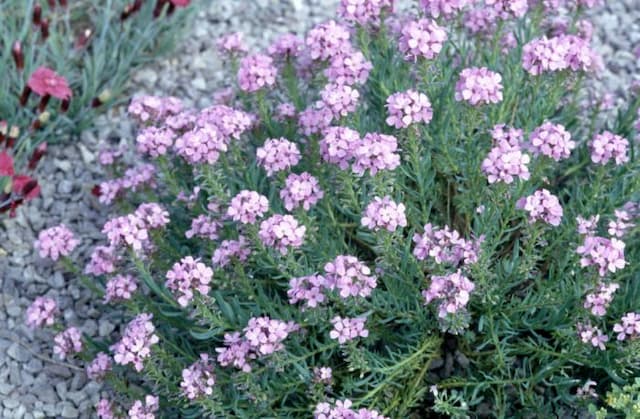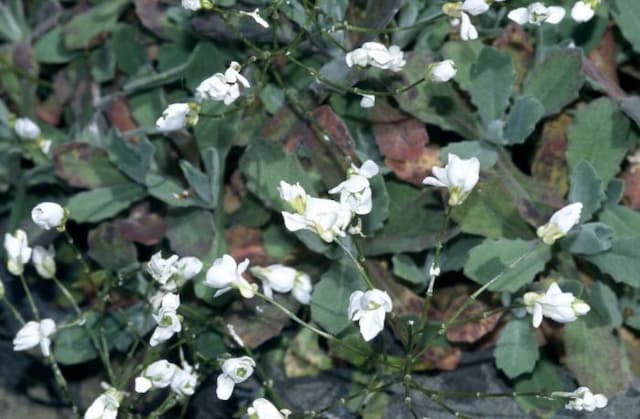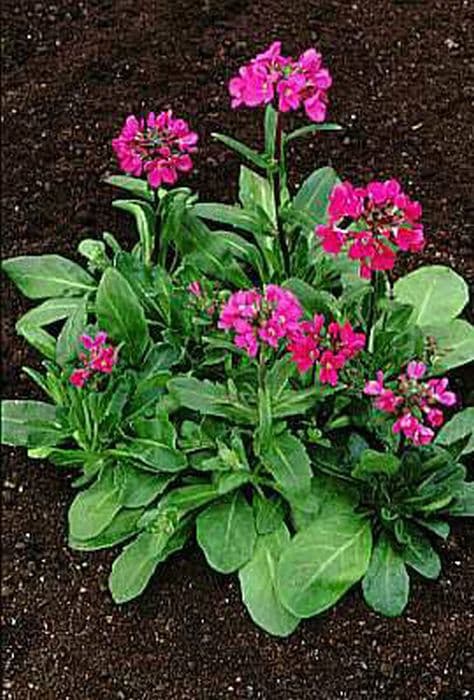Stock Matthiola incana Wisley selection

ABOUT
The Matthiola incana Wisley selection, commonly known as stock, is a plant renowned for its delightful fragrance and beautiful blooms. The appearance of the plant is characterized by its dense clusters of flowers that come in a variety of colors including white, pink, mauve, and purple. Each flower is composed of four petals that are intricately arranged in a way that delivers an aesthetic appeal. The petals have a delicate texture that is velvety to the touch. The leaves of the stock plant extend from the stems with a greyish-green hue. They are lance-shaped and slightly serrated on the edges, contributing to the overall textured look of the foliage. These leaves provide a lovely backdrop to the vibrant flowers and add to the visual interest of the plant. The stems of the stock are sturdy and upright, supporting the weight of the flowers. They are covered in a fine down, giving them a slightly fuzzy appearance. Collectively, these attributes culminate in a plant that is not only visually striking but also widely appreciated for its sweet and intense aroma which is most pronounced in the evening or at night. These features make the Matthiola incana Wisley selection a popular choice for gardens and floral arrangements, enchanting onlookers, and contributing to a sensory garden experience.
About this plant
 Names
NamesSynonyms
Hoary Stock, Tenweeks Stock, Gillyflower, Brompton Stock, Stock.
Common names
Matthiola incana var. rugulosa, Matthiola longipetala subsp. bicornis, Cheiranthus incanus, Matthiola incana subsp. incana, Cheiranthus incanus subsp. incanus, Matthiola incana subsp. rugulosa, Matthiola incana var. annua, Cheiranthus annuus, Cheiranthus longipetalus, Matthiola longipetala, Matthiola bicornis.
 Toxicity
ToxicityTo humans
Stock, also known as Matthiola incana Wisley selection, is not commonly known for being toxic to humans. There is limited documentation on poisoning or toxicity resulting from ingesting this plant. However, since some plants can cause allergic reactions or skin irritation, it is generally advisable to avoid ingesting plant parts unless they are known to be edible.
To pets
Stock, also known as Matthiola incana Wisley selection, does not typically appear on lists of plants known to be toxic to pets, including dogs and cats. However, in the absence of specific toxicity data, it is still prudent to prevent pets from ingesting this plant, as individual animals might have different sensitivities or allergic reactions. If a pet ingests part of the plant and shows signs of distress, consult a veterinarian. Generally, symptoms of plant poisoning in pets can include vomiting, diarrhea, lethargy, or more serious signs such as difficulty breathing or changes in heart rate, but these are not specifically associated with ingestion of stock.
 Characteristics
CharacteristicsLife cycle
Biennials
Foliage type
Evergreen
Color of leaves
Grey-green
Flower color
Varies
Height
2 feet (60 cm)
Spread
1 foot (30 cm)
Plant type
Herb
Hardiness zones
7
Native area
Mediterranean
Benefits
 General Benefits
General Benefits- Aesthetic Appeal: Adds vibrant colors and a pleasant fragrance to gardens, enhancing their visual beauty.
- Attracts Pollinators: Welcomes beneficial insects such as bees and butterflies, aiding in pollination.
- Drought Tolerance: Once established, it can withstand dry conditions, reducing the need for frequent watering.
- Cold Resistance: Tolerates cooler temperatures, allowing it to thrive in a variety of climates.
- Cut Flowers: Suitable for bouquets and floral arrangements due to its longevity and appealing scent when cut.
- Seasonal Interest: Blooms in spring and summer, providing interest throughout multiple seasons.
- Easy Propagation: Can be readily propagated from seed, allowing gardeners to grow multiple plants economically.
- Compact Growth: Ideal for borders and containers due to its manageable size and neat growth habit.
- Low Maintenance: Generally requires minimal care, making it suitable for novice gardeners or those with limited time.
- Versatility: Can be used in rockeries, traditional flower beds, and as edging plants, offering diverse garden applications.
 Medical Properties
Medical PropertiesThis plant is not used for medical purposes.
 Air-purifying Qualities
Air-purifying QualitiesThis plant is not specifically known for air purifying qualities.
 Other Uses
Other Uses- Perfume Industry: Stock flowers, like those of Matthiola incana, are often used in perfumery for their sweet and intense fragrance, serving as a natural scent in various perfumes.
- Decorative Dried Flowers: The blooms of the stock plant can be dried and used in everlasting flower arrangements or potpourri, retaining their color and part of their scent.
- Floral Displays: Matthiola incana's tall, dense spikes of flowers are used to add height and structure to floral displays and bouquets.
- Wedding Flowers: Due to its pleasant fragrance and attractive blooms, the stock plant is commonly incorporated into wedding bouquets and centerpieces.
- Culinary Garnishes: The flowers of Matthiola incana, although not widely known for culinary uses, can be used as edible decorations on cakes and desserts, provided they are free of pesticides.
- Photo Backdrops: The dense and colorful flower spikes can create a stunning backdrop for photography, especially in spring garden settings.
- Aromatherapy: The relaxing and sweet fragrance of the stock flower can be used in aromatherapy to create calming atmospheres in homes and spa environments.
- Craft Projects: The flowers and seeds of Matthiola incana can be used in various craft projects, including card making, pressed flower art, and decorating homemade candles.
- Fabric Dyeing: The petals of certain varieties of Matthiola incana can be used as a natural dye for fabrics, providing soft colors and an eco-friendly dyeing solution.
- Garden Design: Stock plants are often used in garden design to create colorful borders or as accent plants due to their height and varied colors.
Interesting Facts
 Feng Shui
Feng ShuiThe Stock is not used in Feng Shui practice.
 Zodiac Sign Compitability
Zodiac Sign CompitabilityThe Stock is not used in astrology practice.
 Plant Symbolism
Plant Symbolism- Beauty: Matthiola incana, commonly known as Stock, is often associated with beauty due to its richly scented and visually appealing flowers.
- Longevity: The Stock flower blooms for an extended period, which can symbolize a life that is long-lasting and full of vitality.
- Happy Life: With its delightful fragrance and variety of colors, Stock is often used to represent a wish for a happy and contented life.
- Bond of Love: The flower's pleasant scent and its use in wedding bouquets often symbolize the deep and lasting bond between people in love.
- Promptness: Some cultures may refer to Stock's quick growth and prompt blooming as a symbol of promptness and eager action.
 Water
WaterStock, commonly known as Matthiola incana Wisley selection, requires moderate watering to maintain evenly moist soil, especially during its growing season. It's best to water this plant once every week, adjusting for rainfall and allowing the top inch of soil to dry out between waterings. Provide roughly one gallon of water per plant each time, which allows enough moisture to penetrate deeply to the roots. During winter, water less frequently as the plant's water needs decrease. Avoid overhead watering to prevent issues with mildew and other fungal diseases.
 Light
LightStock thrives in bright, full sun conditions, as it requires plenty of light to bloom profusely. Plant it in a location where it can receive at least six hours of direct sunlight each day. The ideal spot for stock would be a south-facing garden bed or a window that gets abundant sunshine throughout the day.
 Temperature
TemperatureStock prefers cooler temperatures and can generally tolerate temperatures down to about 35°F without damage. The ideal temperature range for stock is between 50°F and 65°F during the day, with cooler nights. While it is cold-tolerant, temperatures above 75°F may inhibit flowering and can stress the plant.
 Pruning
PruningPruning stock is important for encouraging full, bushy growth and continued blooming. Pinch back the tips of young plants to promote branching and deadhead spent flowers regularly to stimulate new blooms. Prune stock after the main flowering display has ended, typically in late summer or early fall.
 Cleaning
CleaningAs needed
 Soil
SoilStock (Matthiola incana 'Wisley Selection') prefers well-draining soil that is moderately fertile with a neutral to slightly alkaline pH, ideally between 7.0 and 7.5. A mix of garden soil, compost, and grit or perlite encourages healthy growth.
 Repotting
RepottingStock should be repotted annually in the spring, especially if growing in containers, to replenish nutrients and prevent root crowding.
 Humidity & Misting
Humidity & MistingStandard room humidity is generally acceptable for Stock, but it benefits from moderate humidity levels without needing specific adjustments.
 Suitable locations
Suitable locationsIndoor
Place Stock in bright light and cool temps indoors.
Outdoor
Plant Stock in full sun and protect from strong winds.
Hardiness zone
7-10 USDA
 Life cycle
Life cycleMatthiola incana, commonly known as hoary stock, begins its life cycle as a seed, which when sown in fertile, well-drained soil and provided with enough light, germinates usually within 1 to 2 weeks. Following germination, the seedling emerges and develops a rosette of lance-shaped leaves, gradually forming a bushy plant. This stage includes vegetative growth where the plant matures and establishes a strong root system. As it enters the flowering stage, usually in late spring to summer, Matthiola incana produces clusters of fragrant flowers on tall spikes, which come in a variety of colors including white, pink, lavender, and purple. After pollination, the flowers develop into elongated seed pods that release seeds when mature, completing the reproductive phase. Depending on the climate, Matthiola incana may act as an annual or a biennial, dying after seed production or persisting to grow and bloom in the following season.
 Propogation
PropogationPropogation time
Spring-Early Summer
Matthiola incana, commonly known as stock or gillyflower, is often propagated through seeds. The most popular method of propagation for this plant is sowing seeds. This can be done by scattering the seeds lightly on the surface of a well-draining soil mix in a seed tray or pots. Propagation is best done in late winter to early spring, allowing for the cool temperatures that favor germination. The seed tray should be kept moist but not waterlogged, and it is typically covered with a light layer of soil or vermiculite, no more than 1/8 inch (about 3 millimeters) thick. Germination usually occurs within one to two weeks when kept at temperatures around 60-65 degrees Fahrenheit (15-18 degrees Celsius). Once seedlings emerge and grow strong enough, they are thinned out and transplanted to their final growing positions after the risk of frost has passed.







![Aubrieta [Axcent Burgundy]](/_next/image?url=https%3A%2F%2Fplants-admin.emdemapps.com%2Fimages%2Fplants%2F%2Fimages%2F604b5b7b548d8.png&w=640&q=75)

